Armed Forces of Ukraine
The Armed Forces of Ukraine (Ukrainian: Збройні сили України [ЗСУ]; Zbroyni Syly Ukrayiny, [ZSU]) is the military of Ukraine. They are the principal deterrent force against any aggression that could be shown against the sovereign state of Ukraine. All military and security forces, including the Armed Forces, are under the command of the President of Ukraine, and subject to oversight by a permanent Verkhovna Rada parliamentary commission.
| Armed Forces of Ukraine | |
|---|---|
| Збройні сили України | |
 Emblem of the Ukrainian Armed Forces | |
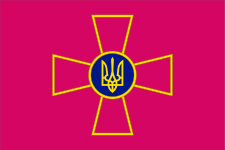 Flag of the Ukrainian Armed Forces | |
| Founded | 1917 |
| Current form | 6 December 1991[1] |
| Service branches | |
| Headquarters | Ministry of Defence Building, Povitroflotskyi Square, Kiev |
| Leadership | |
| Supreme Commander-in-Chief | |
| Minister of Defence | |
| Chief Commander of Armed Forces[4] | |
| Manpower | |
| Military age | 18[5] |
| Conscription | 12 months (GF, AF) 18 months (Navy) |
| Available for military service | 11,149,646, age 16–49 (2015[6]) |
| Fit for military service | 6,970,035, age 16–49 (2015[7]) |
| Reaching military age annually | 482,000 (2018) (2015[8]) |
| Active personnel | 255,000 (2018)[9] (ranked 29) |
| Reserve personnel | 1,000,000 (2018)[10] |
| Deployed personnel | 60,000[11] |
| Expenditures | |
| Budget | UAH 136 billion ($5.4 billion)(2020)[12] |
| Percent of GDP | 3% (2020)[12] |
| Industry | |
| Domestic suppliers | Ukroboronprom (Ukrainian Defence Industry) |
| Foreign suppliers | Former: |
| Related articles | |
| History | Ukrainian–Soviet War Polish–Ukrainian War 1992–94 Crimean crisis Kosovo Force UNAMSIL Tuzla Island conflict ISAF Iraq War ONUCI Operation Ocean Shield MONUSCO Operation Atalanta Pro-Russian unrest in Ukraine Annexation of Crimea War in Donbass |
| Ranks | Military ranks of Ukraine |
| Military History of Ukraine |
|---|
|
|
|
|
|
|
|
|
|
|
|
|
|
|
|
|
|
|
|
|
|
|
|
|
|
|
|
|
|
|
|
|
|
|
|
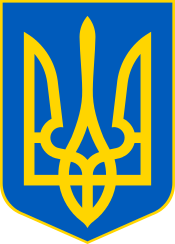 |
|---|
| This article is part of a series on the politics and government of Ukraine |
|
Presidency
|
|
Executive |
|
|
|
The Armed Forces of Ukraine are composed of the Ukrainian Ground Forces, the Ukrainian Navy, the Ukrainian Air Force, and the Ukrainian Airmobile Forces. Ukraine's naval forces maintain their own small Ukrainian Naval Infantry force as well as their own Ukrainian Naval Aviation force. The Ukrainian Sea Guard is the coast guard service of Ukraine, however, it is part of the State Border Guard Service of Ukraine and is not subordinate to the Navy. As a result of the Russian military intervention in Ukraine from 2014, the president commissioned governors of oblasts of Ukraine to create volunteer units under the government program "Territorial Defense". Initially these units received minimal funding coming from regional budgets and mostly relied on donations. In November 2014 most of the territorial battalions were integrated into Ukraine's Ground forces.
The National Guard of Ukraine serves as the main reserve component of the Armed Forces of Ukraine.
Due to ongoing hostilities with Russia, Ukraine has greatly increased the size of its military forces to 204,000 soldiers (+46,000 civil servants) in 2014, not counting paramilitary forces such as the border guards (53,000), the newly formed National Guard of Ukraine (60,000) or the security service.[14] The size of Ukraine's armed forces, which maintains a 255,000 man force, is the third-largest in Europe after the Russian and French Armed Forces.[15] It was reported that Ukraine's military swelled to 280,000 personnel. This was largely achieved by the repeated waves of mobilization bringing in new recruits while older soldiers had not yet been demobilized, the state budget for 2015 ultimately called for a force of 230,000. Hryhoriy Pedchenko reported that 51% of Ukraine's enlisted personnel were contracted soldiers.[16][17]
Military units of other states participate in multinational military exercises with Ukrainian forces in Ukraine regularly.[18] Many of these exercises are held under the NATO co-operation program Partnership for Peace.
Since 3 June 2016, women have been allowed to serve in combat units of the Armed Forces.[19]
History
Origins of the post-1992 Ukrainian Armed Forces
As of 1992, the Ukrainian Armed Forces were completely inherited from the Soviet Union, in which Ukraine had been a member state (a union republic). Like other Soviet republics, it did not possess its own separate military command, as all military formations were uniformly subordinated to the central command of the Armed Forces of the USSR. Administratively, the Ukrainian SSR was divided into three Soviet military districts (the Carpathian Military District, Kiev Military District, and Odesa Military District). Three Soviet air commands and most of the Black Sea Fleet naval bases were located on the coast of Ukraine.
When the collapse of the Soviet Union took place in 1991 (see Novo-Ogaryovo process), the newly independent state of Ukraine inherited one of the most powerful force groupings in Europe. According to an associate of the Conflict Studies Research Centre, James Sherr: "This grouping, its inventory of equipment and its officer corps was designed for one purpose: to wage combined arms, coalition, offensive (and nuclear) warfare against NATO on an external front".[20] At that time, the former Soviet armed forces in the Ukrainian SSR included a rocket army (43rd Rocket Army), four air-force armies, an air-defense army (8th Air Defence Army), three regular armies, two tank armies, the 32nd Army Corps, and the Black Sea Fleet.[21] Altogether the Armed Forces of Ukraine included about 780,000 personnel, 6,500 tanks, about 7,000 combat armored vehicles, 1,500 combat aircraft, and more than 350 ships. Along with their equipment and personnel, Ukraine's armed forces inherited the battle honors and lineage of the Soviet forces stationed in Ukraine. However, due to the deterioration of Russian-Ukrainian relations and to the continued stigma of being associated with the Soviet Union, in 2015 the President of Ukraine ordered the removal of most of the citations awarded to the Ukrainian units during the Soviet era.[22]
On 26 February 1991, a parliamentary Standing Commission for Questions of Security and Defense was established. On August 24, 1991, the Ukrainian parliament (the Verkhovna Rada), in adopting the Declaration of Independence of Ukraine, also enacted a short resolution "About military formations in Ukraine".[23] This took jurisdiction over all formations of the armed forces of the Soviet Union stationed on Ukrainian soil and established one of the key agencies, the Ukrainian Ministry of Defense.[24] On 3 September 1991, the Ministry of Defence commenced its duties. On 22 October 1991 units and formations of the Soviet Armed Forces on Ukrainian soil were nationalized.[25] Subsequently, the Supreme Council of Ukraine adopted two Laws of Ukraine on December 6, 1991,[26][27] and Presidential Ukase #4 "About Armed Forces of Ukraine" on December 12, 1991.[28] The government of Ukraine surrendered any rights of succession to the Soviet Strategic Deterrence Forces[29] (see Strategic Missile Troops) that were staged on the territory of Ukraine. Recognizing the complications of a smooth transition and seeking a consensus with other former members of the Soviet Union in dividing up their Soviet military inheritance, Ukraine joined ongoing talks that started in December 1991[30] regarding a joint military command of the Commonwealth of Independent States.[31]
Inherent in the process of creating a domestic military were political decisions by the Ukrainian leadership regarding the country's non-nuclear and international status. Among these were the definition, agreement, and ratification of the 1990 Treaty on Conventional Armed Forces in Europe (CFE) which not only established the maximum level of armament for each republic of the former USSR, but also a special ceiling for the so-called CFE "Flank Region". Included in this region were Ukraine's Mykolaiv, Kherson and Zaporizhia Oblasts, and the Autonomous Republic of Crimea. Another key event in the development of the Ukrainian military was the 1992 Tashkent Treaty, which laid out aspirations for a Commonwealth of Independent States military. This collective military proved impossible to develop because the former republics of the USSR all wished to go their own way, ripping the intricate Soviet military machine into pieces.
Ukraine had observer status with the Non-Aligned Movement of nation-states from 1996.[32] However, due to the 2014 Russian aggression against Ukraine, the Verkhovna Rada repealed this status on 23 December 2014.[33]
Arms Control and Disarmament
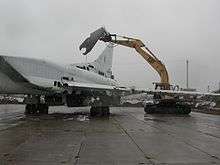
Following the breakup of the Soviet Union, Ukraine inherited two divisions of the Strategic Rocket Forces' 43rd Rocket Army (HQ Vinnytsia): the 19th Rocket Division (Khmelnytskyi) (90 UR-100N/SS-19/RS-18) and the 46th Rocket Division at Pervomaisk, Mykolaiv Oblast, equipped with 40 SS-19 and 46 silo-mounted RT-23 Molodets/SS-24s.[34] While Ukraine had physical control of these systems, it did not have operational control. The use of the weapons was dependent on Russian-controlled electronic Permissive Action Links and the Russian command and control system.[35][36]
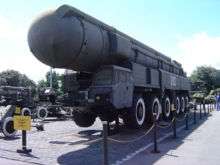
Ukraine voluntarily gave up these and all other nuclear weapons during the early 1990s. This was the first time in history that a country voluntarily gave up the use of strategic nuclear weapons, although the Republic of South Africa was dismantling its small tactical nuclear weapons program at about the same time.
Ukraine has plentiful amounts of highly enriched uranium, which the United States wanted to buy from the Kharkiv Institute of Physics and Technology. Ukraine also has two uranium mining and processing factories, a heavy water plant and technology for determining the isotopic composition of fissionable materials. Ukraine has deposits of uranium that are among the world's richest. In May 1992, Ukraine signed the Strategic Arms Reduction Treaty (START I) in which the country agreed to give up all nuclear weapons and to join the Nuclear Non-Proliferation Treaty as a non-nuclear weapon state. Ukraine ratified the treaty in 1994, and as of January 1, 1996, no military nuclear equipment or materials remain on Ukrainian territory.
On 13 May 1994, the United States and Ukraine signed a Memorandum of Understanding on the Transfer of Missile Equipment and Technology. This agreement committed Ukraine to the Missile Technology Control Regime (MTCR) by controlling exports of missile-related equipment and technology according to the MTCR Guidelines.
Other disarmament – strategic planes & other missiles
Ukraine and NATO estimate that 2.5 million tons of conventional ammunition were left in Ukraine as the Soviet military withdrew, as well as more than 7 million rifles, pistols, mortars, and machine guns. The surplus weapons and ammunition were stored in over 180 military bases, including in bunkers, salt mines and in the open.[37] As of 2014, much of this surplus had not been scrapped.[38][39]
Attempt at Reforms and Constant Fund Shortages
Ukraine's first military reforms began on December 26, 1996, with the adoption of a new "State Program for the Building and Development of the Armed Forces of Ukraine". One of the aspects was to shrink the standard combat unit from division size to brigade size which would then fall under the command of one of the three newly created military district; the Western Operational Command, the Southern Operational Command, and the largest – the Northern Operational/Territorial Command.[40] Only Ukraine's 1st Airmobile Division was not downsized. This downsizing occurred purely for financial reasons with Ukrainian economy in recession this was a way to shrink the government (defense) expenditure and at the same time release hundreds of thousands of young people into the private sector to stimulate growth.[41] During this time Ukraine's military-industrial complex also began to develop new indigenous weapons for the armed forces like the T-84 tank, the BMP-1U, the BTR-3, KrAZ-6322, and the Antonov An-70. All these reforms were championed by Leonid Kuchma, the 2nd President of Ukraine, who wanted to retain a capable military and a functioning military-industrial complex because he didn't trust Russia who he believed might one day become Ukraine's enemy, stating once "The threat of Russofication is a real concern for us".[42]
Kuchma was also eager to modernize the equipment of the Ukrainian Armed Forces, however, after learning of the price tag of such a move, he backtracked, preferring to rely on the sizable Soviet supply of weapons which he made sure were well maintained. But the cancellation of the modernization program left a question of how to provide jobs in the military industrial complex which then comprised a double-digit percentage of the GDP. Export of new and modernized weapons on the world's arms markets was settled on as the best option, where Ukraine both tried to undercut the contracts of the Russian arms industry – offering the same service for a cheaper price, and was willing to sell equipment to whoever was willing to pay (more than once to politically unstable or even aggressive regimes), causing negative reactions from both Western Europe and the United States federal government.[43] During this time 320 T-80 tanks would be sold to Pakistan and an unfinished Soviet aircraft carrier the Varyag which today is known as the Chinese aircraft carrier Liaoning.[44]
Though the military was well equipped it still experienced lack of funds particularly for training and exercises, which led to a number of incidents with one notable one being the Siberia Airlines Flight 1812 of 2001 the other Sknyliv airshow disaster of 2002. Still, the military's effectiveness was demonstrated during the Tuzla Island Conflict – when (brief description). In 2003 Ukraine completed its first set of reforms which were judged largely successful, with the personnel numbers stabilizing at 295,000 of which 90,000 were civilian contractors.[45]
- Second phase 2004–2010
- downsizing further
- training
- maintenance and new equipment
- NATO and Russia
- 2008 financial crisis
- The Yanukovich Catastrophe (2011–2014)[46]
- appointment of Russian citizens to the ministry of defense and intelligence
- downsizing
- lack of funds for exercise, vehicle maintenance, and even monthly paychecks
- scrapping and sale of equipment
- incompetence in, and destruction of the military industrial complex
Ukrainian military tactics and organization are heavily dependent on Cold War tactics and former Soviet Armed Forces organization. Under former President Yushchenko, Ukraine pursued a policy of independence from Russian dominance, and thus tried to fully integrate with the West, specifically NATO.
Until the Euromaidan crisis of 2014, Ukraine retained tight military relations with Russia, inherited from their common Soviet history. Common uses for naval bases in the Crimea and joint air defense efforts were the most intense cooperative efforts. This cooperation was a permanent irritant in bilateral relations, but Ukraine appeared economically dependent on Moscow, and thus unable to break such ties quickly. After the election of President Victor Yanukovych, ties between Moscow and Kiev warmed, and those between Kiev and NATO cooled, relative to the Yushchenko years.
Conflict in Southeastern Ukraine (2014 – present)
.jpg)
In March 2014, after the Crimean crisis began, it was announced by the reformist government that a new military service, the National Guard of Ukraine would be created. Previously a National Guard had existed up until 2000, thus the 2014 NG is a reformation of the one raised in 1991, but this time formed part of personnel from the Internal Troops of Ukraine.
In May 2014 with war happening in eastern regions, a helicopter with 14 soldiers on board including General Serhiy Kulchytskiy, who headed combat and special training for the country's National Guard, was brought down by militants near Sloviansk in East Ukraine. Outgoing President Olexander Turchynov described the downing as a "terrorist attack," and blamed pro-Russian militants.[47]
In the early months of the War in Donbass, the Armed Forces were widely criticised for their poor equipment and inept leadership, forcing Internal Affairs Ministry forces like the National Guard and the territorial defence battalions to take on the brunt of the fighting in the first months of the war.[48][49]
In late July 2015, the Ukrainian Defense Ministry revealed new Ukrainian Armed Forces uniform designs, later a revised rank insignia system was created.[50] These made their national debut on August 24, 2016, at the National Independence Day Silver Jubilee parade in Independence Square, Kiev.
By February 2018 the Ukrainian armed forces were larger and better equipped than ever before, numbering 200,000 active-service military personnel and most of the volunteer soldiers of the territorial defence battalions have been integrated into the official Ukrainian army.[51]
A late 2017-early 2018 United Nations Human Rights Monitoring Mission in Ukraine reported that human rights abuses allegedly committed by Ukrainian security forces and armed groups remain an ongoing issue of the War in Donbass that erupted in 2014. The nature of the alleged crimes ranges from unlawful or arbitrary detention to torture, ill-treatment and/or sexual violence. Within the reporting period of 16 November 2017 to 15 February 2018 the OHCHR monitoring mission documented 115 cases of credible allegations of human rights violations committed by both sides of the conflict since 2014.[52]
Ukraine & NATO Membership
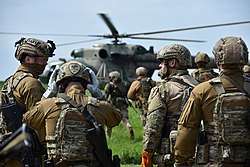
Ukraine's stated national policy is Euro-Atlantic integration, with the European Union. Ukraine has a "Distinctive Partnership" with NATO (see Enlargement of NATO) and has been an active participant in Partnership for Peace exercises and in peacekeeping in the Balkans. This close relationship with NATO has been most apparent in Ukrainian cooperation and combined peacekeeping operations with its neighbor Poland in Kosovo. Ukrainian servicemen also serve under NATO command in Iraq, Afghanistan and in Operation Active Endeavour.[53] Former Ukrainian President Viktor Yanukovych considered the level of co-operation between Ukraine and NATO sufficient.[54] His predecessor Viktor Yushchenko had asked for Ukrainian membership by early 2008.[55][56] During the 2008 Bucharest summit NATO declared that Ukraine will become a member of NATO whenever it wants and when it meets the criteria for accession.[54] Former Ukrainian President Yanukovych opted to keep Ukraine a non-aligned state. This materialized on June 3, 2010 when the Ukrainian parliament excluded, with 226 votes, the goal of "integration into Euro-Atlantic security and NATO membership" from the country's national security strategy.[57] Amid the Euromaidan unrest, Yanukovych fled Ukraine in February 2014.[58]
The interim Yatsenyuk Government which came to power, initially said, with reference to the country's non-aligned status, that it had no plans to join NATO.[59] However, following the Russian military intervention in Ukraine and parliamentary elections in October 2014, the new government made joining NATO a priority.[60] On 23 December 2014, the Ukrainian parliament renounced Ukraine's non-aligned status[58][61] that "proved to be ineffective in guaranteeing Ukraine's security and protecting the country from external aggression and pressure".[62] The Ukrainian military is since transforming to NATO standards.[63] Ukrainian Prime Minister Arseniy Yatsenyuk stated early February 2016 that de facto the Armed Forces must, soon as possible, begin its transition for Ukrainian entry into NATO and towards NATO-capable armed forces.[63]
Organization

In late 2010 the total personnel (including 41,000 civilian workers) was 200,000.[64] Conscription was ended in October 2013;[65] at that time the Ukrainian armed forces were made up of 40% conscripts and 60% contract soldiers.[65] In April 2014 acting President Oleksandr Turchynov reinstated conscription in May 2014.[66]
In early 2014, Ukraine had 130,000 personnel in its armed forces that could be boosted to about one million with reservists.[66]
There is a reported total of 250,800 personnel in the Armed Forces in 2015.[67]
Ukraine maintained until 2016 a number of Guards units, tracing their traditions to the Soviet Armed Forces. A list can be seen at List of guards units of Ukraine. There were reports in 2015 that all Guards units had been either disbanded or reformed to regular units, this was proven false as all their Soviet decorations were removed from their titles and regimental colours by 15 November the same year due to the decommunization process in Ukraine which ceased promotion and glorification of the Soviet symbols. (On August 22, 2016, the Guards titles were removed from the unit titles.) Only one brigade, the 51st, a former Guards unit, had been dissolved the year before.
Following the Russian aggression, Ukraine has adopted a new military doctrine (third edition) which made the Russian Federation its main opponent and announced Ukraine's intentions for closer relations with NATO armed services, most especially if it will join the organization in the future.[68]
Chief of the General Staff
The Chief of the General Staff oversees the Armed Forces of Ukraine.
Ukrainian Ground Forces
.jpg)
As of 2016, there were a reported 169,000 personnel in the Ukrainian Ground Forces.[69] The Ukrainian Ground Forces are divided into Armoured and Mechanized Forces, Army Aviation, Army Air Defence and Rocket and Artillery Troops. There are 13 mechanized brigades and two mountain warfare brigades in the Mechanized Forces. Ukraine also has two armoured brigades. There are seven rocket and artillery brigades as well as five airmobile brigades. Until 2013, the Ground Forces were divided into three army corps. These were disbanded in 2013 and reorganized as Operation Command West, Operation Command North and Operation Command South. Operation Command East was formed in 2015 to coordinate forces in the War in Donbass.
.jpg)
Ukrainian Air Force
In 2016, the Ukrainian Air Force was reported to have included 36,300 personnel.[70][71]
Ukrainian Navy
.jpg)
According to an August 2015 Kyiv Post report, the Ukrainian Navy consisted of 6,500 personnel.[73]
Air Assault and Airborne Forces
The Ukrainian Air Assault Forces are composed of 8 air assault brigades and support units.
Special Forces
Ukraine's special forces are reported as 4,000 strong.[2]
Personnel and conscription
The Soviet Union required all able-bodied male citizens to serve two years in the armed forces (three years if drafted into the navy), although the draft could be postponed due to continued higher education. It was possible to be drafted into non Ministry of Defense military forces such as the KGB Border Guards, the Militsiya, or the Internal Troops. When Ukraine gained its independence it retained the policy of conscription, although the time in service was reduced to 18 months in the navy and one year in all other services. Ukraine also gradually began recruiting professional soldiers, although in almost all cases a person had to serve as a conscript prior to becoming a professional soldier. The Ukrainian Naval Infantry was the first service to convert to being staffed by fully professional marines.
In October 2013 President Yanukovich ended conscription in Ukraine, at the time 60% of Ukraine's forces were composed of professional soldiers.[74] However, due to the 2014 Russian military intervention in Ukraine conscription, as well as a partial mobilization, was reinstated in 2014.[75] Ukraine has modified the age group of males eligible for conscription for 2015 from 18–25 to the 20-27 age group.[76]
After serving out the term of service Ukraine's conscripts become part of the inactive reserve and are eligible to be recalled for mobilization until they reach age 55, age 60 for officers. Due to the War in Donbass Ukraine has instated a partial mobilization to fill needed positions in its armed forces, recalling conscripts who have served before, because of the war many conscripts have also been forced to serve longer than their original 18-month term of service.[77] It was planned that in 2015 Ukraine would undergo three waves of partial mobilization, this would have allowed new troops to replace those serving longer than their original term of service.[78] As a result, the number of defections from Ukrainian Armed Forces has risen substantially cause the Ukrainian conscripts had no wish to put their life at risk in combat. An advisor of Ukrainian president described the quality of forcibly mobilized Ukrainian soldiers as "alcoholics and dodgers, drug addicts and morons".[79] According to many reports the increased consumption of drugs and alcohol on duty has become a serious issue in Ukrainian Armed Forces. As a response the Ukrainian government launched a military police service and deployed National Guards in war zone.[80][81][82]
Due to the reintroduction of conscription, and partial mobilization, Ukraine's armed forces is expected to nearly double from approximately 130,000 personnel in December 2014 to approximately 250,000 personnel in 2015.
All medical workers in Ukraine, regardless of gender, are eligible to be called up for service in case of a national emergency.
Draft dodging is present in Ukraine as with most nations using the draft. It was reported that between April and August 2014, over 1,000 criminal inquires into draft evasion were opened in Ukraine.[83] Draft evasion can be problematic because unless a male citizen was unable to serve for medical reasons, an application to receive an international passport of Ukraine may be denied due to a lack of military service, thus preventing the individual from traveling abroad.[84]
As of autumn 2016, conscripts were no longer deployed in the so-called "ATO"-operations in the east of Ukraine.[85]
Contract service
In 2017 more than 14 thousand people signed up for contract service with the Armed Forces.[86]
For participating in the War in Donbass (in May 2017 7.5 thousand) soldiers on the front line receive an average salary of 16 thousand Ukrainian Hryvnia.[86] The minimum maintenance for a contract soldier is 7000 Hryvnia.[86]
West Ukraine supplies the fewest people for contract service.[86]
Paramilitary forces
Ukraine's Armed Forces outside the jurisdiction of the Ministry of Defense consist of:
- Internal Troops → National Guard (Ministry of Internal Affairs): 46,000 [87]
- Special operation formations of the Ministry of Internal Affairs, i.e. Omega, Scorpion (nuclear sites security), Tytan, and others. Most of Felidae-named formations (such as Bars, Jaguar, others) along with Berkut were reformed.
- Border Guard: 42,000 (including 8,000 civilian workers)[87]
- Ukrainian Sea Guard – the coast guard within the State Border Guard Service of Ukraine
- Various military troops of the SBU (no generic name): 30,000
- Civil Defence Forces (State Emergency Service of Ukraine): 10,218 (including 668 civilian workers)[88]
- Special Transportation Service of Ukraine – (Ministry of Transportation and Communications)[89]
Although not components of the Armed Forces, these militarized institutions are supposed to come under the Armed Forces' command during wartime.
Role of women
On 3 June 2016, Defense Ministry's Order No. 292 allowed women to serve in combat units.[19]
According to Defense Ministry figures early June 2016 some 49,500 women served in and worked in the Ukrainian military; more than 17,000 were military servicewomen, of which more than 2,000 officers.[19] Women have also joined the various volunteer Territorial defense battalions before the order for women's integration in the armed forces was enacted.[19] Women are eligible to be drafted into the military as officers.[90] In 2009 women comprised almost 13% of the armed forces (18,000 personnel) but with few females holding high rank (2.9% or 1,202 women).[91] Contractual military service accounted for almost 44% of women. However, this being closely linked to the low salary of such positions: men refuse to serve in these conditions while women accept them.[91]
Nadiya Savchenko is perhaps one of the most well known female Ukrainian soldiers and was held as a prisoner in Russia from July 2014 until May 2016.[92]
According to President Petro Poroshenko, in October 2016 about ten thousand women served in combat units.[93]
In September 2018 legislation made women and men equal in the military and law enforcement agencies.[94] The following month Liudmyla Shugaley became Ukraine's first female general (she was appointed the head of the Military Medical Directorate of the Security Service of Ukraine).[94]
Education and schools
A number of universities have specialized military institutes, such as the Faculty of Military Legal Studies at Kharkiv's National Yaroslav Mudryi Law Academy of Ukraine. The primary Ukrainian military academies are:
- Hetman Petro Sahaidachnyi National Ground Forces Academy, Lviv
- Admiral Pavel Nakhimov Naval Academy, Sevastopol
- transferred to Mykolaiv
- Ivan Kozhedub National Air Force University, Kharkiv
In addition the Ivan Chernyakhovsky National Defense University of Ukraine is in Kiev.[95]
The Central Hospital of the Armed Forces is located in Kiev.[96]
The armed forces' military high school is located in Kiev – the Ivan Bohun Military High School.
Recent operations

Ukraine has been playing an increasingly larger role in peacekeeping operations. Since 1992, over 30,000 soldiers have taken part in missions in the former Yugoslavia (IFOR in Bosnia and Herzegovina, UNPROFOR and UNTAES in Croatia, KFor in Kosovo), the Middle East (Southern Lebanon, Kuwait, Iraq), and Africa (Angola, Sierra Leone, Liberia).[97]
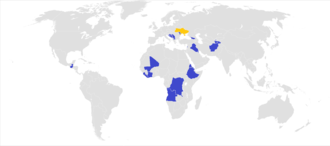
Since 1997, Ukraine has been working closely with NATO and especially with Poland. A Ukrainian unit was deployed as part of the multinational force in Iraq under Polish command. Ukrainian troops are also deployed as part of the Ukrainian-Polish Battalion (UKRPOLBAT) in Kosovo. The total Ukrainian military deployment around the world as of 1 August 2009 was 540 servicemen participating in 8 peacekeeping missions.[97]
The first battle of a regular formation of the Ukrainian Armed Forces happened on April 6, 2004 in Kut, Iraq, when the Ukrainian peacekeeping contingent was attacked by militants of the Mahdi Army. The Ukrainians took fire, and over several hours held the objectives they had been assigned to secure.[98]

Ukrainian troops as part of the former Soviet Armed Forces contingent participated in UNPROFOR in 1992, and in the summer of that year were involved into the civil war in Yugoslavia. On July 3, 1992 the Verkhovna Rada adopted a resolution committing the Ukrainian Armed Forces to UN peacekeeping missions. The Minister of Defense, Kostyantyn Morozov, ordered the creation of the 240th Separate Special Battalion (UKRBAT-1) which was based on the 93rd Guards Motor Rifle Division (now the 93rd Mechanized Brigade). Soon after arrival in Sarajevo on July 31, 1992, the battalion's artillery ended up in the middle of a mutual mortar fight between the Bosnian Serbs and Bosnian Muslims. One of the Serbian shells hit the Ukrainian position, seriously wounding seven soldiers, one of whom died after hospitalization in Germany.
Since gaining independence Ukraine has deployed troops to Iraq, Afghanistan, Kosovo, as well as dedicating peacekeepers to UN missions to Africa (including helicopter units). Ukrainian naval units also participated in anti piracy operations off the coast of Somalia prior to being recalled due to the 2014 Russian intervention in Ukraine.[99]
On 19 January 2015 Ukraine's 18th separate helicopter detachment along with other MONUSCO troops carried out a successful operation eliminating 2 camps belonging to illegal armed groups in the Democratic Republic of the Congo.[100]
Deployment outside Ukraine
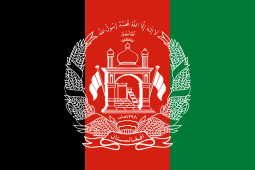
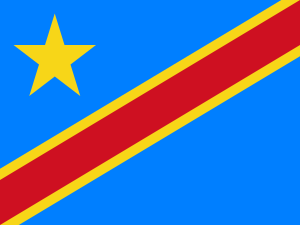
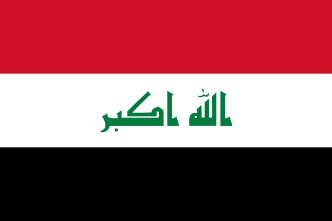


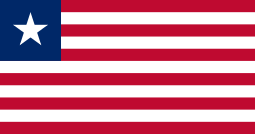
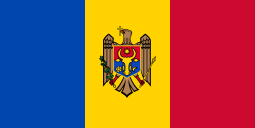


Traditions
- On 9 August 2018, President Petro Poroshenko announced that the Battle cry Glory to Ukraine will be the official greeting of the armed forces, replacing the Soviet era military greeting of Hello Comrades (Вітаю товариші, Vitayu tovaryshi).[108] The greeting was first used during the Kiev Independence Day Parade that year celebrating the centennial of the Ukrainian state.[109][110] It is also the official greeting of the National Police of Ukraine.[111]
- The Central House of Officers of the Armed Forces of Ukraine is the cultural center of the Ukrainian military located in Kiev. Since its recent reorganization, it has become one of the leading cultural centers in the Ukrainian capital. It served as a concert hall for military officers in the post-war years, during which the whole city of Kyiv was in ruins and there were practically no audience halls. It has hosted the National Military History Museum since October 1995.[112]
- The Ukrainian Army unveiled its current uniform on Independence Day in 2016.[113] The new uniforms were modeled on British and Polish military styles[113] and incorporate details from the uniforms worn by the Ukrainian People's Army.[113] The cap includes an insignia of a Ukrainian Cossack grasping a cross.[113] Although mainly designed for the ground forces, other branches based their new uniforms off of the update. Prior to 2016, the uniforms were based on the Soviet military precedent.
- The military uses the Soviet goosestep (originally used by Prussia under the orders of King Frederick the Great) with the speed of the step being 75 steps per minute and elements of the marching pace of the Sich Riflemen.[114][115]
- When in the present arms position, all unit colors are required to dip.
- The S. Tvorun arrangement of the Zaporizhian March has been used in the ZSU since 1991 when it replaced Farewell of Slavianka in being performed during recruiting days, when new servicemen are welcomed to the Armed Forces and recite their enlistment oaths.
Budget
Ukraine's National Security Strategy foresees that its National Security and Defense budget should be at least 5% of Ukraine's GDP.[116]
On 21 December 2016 the Ukrainian parliament adopted its 2017 National Security and Defense budget worth $5.172 billion; that being 5% of Ukraine's GDP. In 2016 defense expenditures amounted to $4.4 billion in 2016, or 5% of the GDP.[117][118] This (2016 figure) was a 23% increase from 2013 and a 65% increase from 2005.[117] From the total, 60% was budgeted to be spent on defence and 40% on security and policing.[117] 2016 also saw a 30% increase in weapons development spending.[119]
Corruption, which was practically institutionalized in Ukraine, combined with small budgets left the military in such a depleted condition that their ability to confront the crisis in Crimea and the Donbass was minimal. All Ukrainian defence sector is heavily affected by the systemic corruption which is hindering its capacity to perform the tasks of national security. In addition, it is also undermines popular trust in the military as an institution. Despite a great number of efforts to resolve the issue there are signs that enough is not being done.[120]
Ukrainian government has launched major structural reforms of the army to meet NATO standards by 2020, but not too many believe that it can successfully meet a deadline. Most part of the problems remain intact, for example: lack of civilian and parliamentary control of the armed forces, lack of internal coordination between different departments, poor integration of volunteers into the regular army, impunity and abusive behavior of military personnel in the conflict zone and systemic corruption and nontransparency of financial resources, especially in the Ukroboronprom defense-industry monopoly.[121]
In 2018 the military budget has grown dramatically, to nearly 5% of GDP. Corruption remains a serious problem operating at all levels of Ukrainian society, and the lack of modern military organizational structure has confounded efforts at reform.[122]
Budget per year (Defense budget only, not "Security and Defense" combined)
- 2003: $1.01 Billion (UAH 5.06 billion @5.0 exchange rate)[123]
- 2004: $1.29 Billion (UAH 6.46 billion @5.0 exchange rate)[123]
- 2005: $1.23 Billion (UAH 6.16 billion @5.0 exchange rate)[123]
- 2006: $1.47 Billion (UAH 7.35 billion @5.0 exchange rate)[123]
- 2007: $2.12 Billion (UAH 10.6 billion @5.0 exchange rate)[123]
- 2008: $1.78 Billion (UAH 8.926 billion @5.0 exchange rate)[124]
- 2009: $0.93 Billion (UAH 7.4 billion @8.0 exchange rate)[125]
- 2010: $1.63 Billion (UAH 13.1 billion @8.0 exchange rate)[126]
- 2011: $1.82 Billion (UAH 14.6 billion @8.0 exchange rate)[127]
- 2012: $2.05 Billion (UAH 16.4 billion @8.0 exchange rate)[128]
- 2013: $1.88 Billion (UAH 15.3 billion @8.1 exchange rate) [129]
- 2014: $1.37 Billion (UAH 15.1 billion @11.0 exchange rate) [130]
- 2015: $1.91 Billion (UAH 40.2 billion @21.0 exchange rate) [130]
- 2016: $2.11 Billion (UAH 56 billion) [131]
- 2017: $2.65 Billion (UAH 69 billion) [132]
- 2018: $3.20 Billion (UAH 83.3 billion) [132]
- 2019: $4.08 Billion (UAH 102 billion) [132]
- 2020: $5.2 billion (UAH 130 billion) [133]
"Security and Defense" combined budget apart from Department of Defense (Defense Ministry) for Armed Forces of Ukraine, also includes expenses for Police, Customs, and Border Control.
Military holidays

These are the military holidays observed by all service personnel the Ukrainian Armed Forces.[134]
- May 23 – Naval Infantry Day
- July 8 – Air and Air Defence Forces Day
- First Sunday in July – Navy Day;[135] From 1997 till 2011 this day was celebrated on August 1[136][137]
- August 8 – Signal Corps Day
- September 7 – Military Intelligence Forces Day
- September 9 – Armoured Forces Day
- September 14 – Mobilized Servicemen Day
- October 14 – Defender of Ukraine Day[138]
- October 29 – Finance Officers Day
- November 3 – Rocket Forces and Artillery Day
- November 3 – Corps of Engineers Day
- November 21 – Air Assault Forces Day [139][140][141]
- December 6 – Armed Forces Day; festive fireworks and salutes take place in various cities in Ukraine[142] The holiday was established in 1993 by the Ukrainian parliament.[143]
- December 12 – Ground Forces Day
- December 23 – Operational Servicemen Day
Veterans
Ukraine provides combat veterans with a range of benefits. Ukrainians who served in WWII, the Soviet–Afghan War, or as liquidators at the Chernobyl disaster are eligible for benefits such as monthly allowances, discounts on medical and pharmacy services, free use of public transportation, additional vacation days from work, retention priority in work layoffs, easier access to loans and associated approval processes, preference when applying for security related positions, priority when applying to vocational schools or trade schools, and electricity, gas, and housing subsidies. Veterans are also eligible to stay at military sanatoriums, space permitting. Since gaining independence, Ukraine has deployed troops to Kosovo, Iraq, and Afghanistan, gaining a new generation of veterans separate from those who have served in the Soviet forces. Most recently, the government passed a law extending veteran benefits to Ukrainian troops responding to the War in Donbass. Moreover, veterans from other nations who move to or reside in Ukraine may be eligible for some of the listed benefits, this provision was likely made to ensure WWII, Chernobyl, and Afghanistan veterans from other Soviet states who moved to Ukraine received similar benefits, however as Ukraine has participated in numerous NATO-led conflicts since its independence, it is unclear if NATO veterans would be extended these benefits.[144]
Veteran groups are not as developed as in the United States which has numerous well known national organizations such as the Veterans of Foreign Wars. World War II veterans, and even persons who have lived through the war are generally treated with the highest respect. Other veterans are not as well known. Ukrainian veterans from the Soviet War of Afghanistan are strikingly similar to the Vietnam veterans of the United States. The Soviet Union generally kept the public in the dark through the war, unlike in Vietnam where coverage was very high, Afghanistan is often labeled as a mistake by the Soviet Union and its successor states, the lack of media coverage and censorship through the war also ensured that many still remain unaware of their nations involvement in the conflict.[145] Despite Ukraine having the 3rd largest contingent of troops in Iraq in 2004, few also realize that their nation has many veterans of the Iraq war.
Due to the ongoing conflict with pro-Russian separatists, another generation of veterans appeared in Ukraine. These veterans would be eligible for the same benefits as all others. However, as there was no official declaration of war it was difficult to determine the cut-off date for veteran benefits, leaving many that participated at the beginning of the conflict without benefits. At first, Ukraine only gave benefits posthumously to family members as there was no legal framework to account for the veterans, moreover, members of territorial defense battalions were not eligible for benefits at all. In August, a law was passed granting all service members participating in Ukraine's Anti-Terror Operation the status of veterans, five months after first hostilities broke out in Crimea, the territorial defense battalions were integrated into the National Guard making them part of Ukraine's forces, thus allowing their volunteers to receive veteran status.[146][147]
Veterans of the so-called "ATO"-operations in Donbas are eligible for receiving apartments (if staying in active duty) or a land plot for building purposes of 1000 sqm. in the district of their registration.
On 22 November 2018 the Ministry for Veterans Affairs of Ukraine was officially established.[148]
Military industrial complex
Ukraine received about 30% of the Soviet military industry, which included between 50 and 60 percent of all Ukrainian enterprises, employing 40% of its working population. Ukraine was, and still remains, a leader in missile-related technology,[149] navigation electronics for combat vessels and submarines, guidance systems, and radar for military jets, heavy armoured vehicles.
The military-technical policy in the field of development and modernization of weapons and military equipment provides the Central Scientific Research Insitute of Armaments and Military Equipment of Armed Forces of Ukraine[150].
References
- "Про Збройні Сили України - від 6 December 1991 № 1934-XII". zakon1.rada.gov.ua. Archived from the original on 30 March 2012. Retrieved 1 June 2012.
- Special Operations Forces, what will the new branch be like? Archived 2015-09-21 at the Wayback Machine. ESPRESO. 22 April 2015
- Ukrainian lawmakers appoint Andriy Taran as new defense minister, by UNIAN
- Zelensky appoints Khomchak Chief Commander of Armed Forces, Korniychuk Chief of General Staff, Interfax-Ukraine (28 March 2020)
- "Стаття 15. Призовний вік. Призов громадян України на строкову військову службу. На строкову військову службу в мирний час призиваються придатні для цього за станом здоров'я громадяни України чоловічої статі, яким до дня відправлення у військові частини виповнилося 18 років"
Закон № 2232-XII від 25 March 1992 "Про військовий обов'язок і військову службу" (ред. від 15 January 2015) - CIA World Factbook, Military of Ukraine Archived 2014-01-29 at the Wayback Machine
- CIA World Factbook, Military of Ukraine Archived 2014-01-29 at the Wayback Machine
- CIA World Factbook, Military of Ukraine Archived 2014-01-29 at the Wayback Machine
- "Міністерством оборони визначено основні пріоритети фінансування на 2019 рік".
- "Ukraine's Defense Ministry elaborates on military reserve". UNIAN. Archived from the original on 2016-09-30. Retrieved 2016-10-18.
- "Порошенко: В зоне АТО находятся 60 тысяч украинских военнослужащих". UNIAN. Archived from the original on 2015-06-27. Retrieved 2015-06-26.
- https://www.pravda.com.ua/news/2019/10/8/7228477/
- [U.S. supplies maximum arms to Ukraine: Media],
.svg.png)
- "Ukraine plans to double military budget against fighting in east". Deutsche Welle. 12 December 2014. Archived from the original on 9 February 2016. Retrieved 9 February 2016.
- "Ukraine". Global Fire Power. Archived from the original on 2014-12-29. Retrieved 2014-12-29.
- "During the last year, the Ukrainian army grew from 146 up to 280 thousand, - Poltorak". Archived from the original on 2015-12-08. Retrieved 2015-09-13.
- "Ukrainian Military Personnel". Archived from the original on 2014-12-22. Retrieved 2014-12-22.
- "Parliament approves admission of military units of foreign states to Ukraine for exercises". Kyiv Post. 18 May 2010. Archived from the original on 9 February 2016. Retrieved 9 February 2016.
- War has a female face Archived 2016-08-04 at the Wayback Machine, UNIAN (4 August 2016)
- James Sherr, 'Ukraine's Defense Reform: An Update', Conflict Studies Research Centre, 2002
- Стан Збройних Сил України на момент створення (Status of the Armed Forces of Ukraine at the time of creation) Archived 2012-05-31 at the Wayback Machine. Ukrainian Military in 20-21st centuries.
- УКАЗ ПРЕЗИДЕНТА УКРАЇНИ №646/2015. Official website of the President of Ukraine. Archived from the original on 2016-08-31. Retrieved 2017-06-15.
- Law of Ukraine N 1431-XII. "About military formations of Ukraine Archived 2014-03-02 at the Wayback Machine". Verkhovna Rada. August 24, 1991.
- "Міністерство". Archived from the original on 2007-10-15. Retrieved 2008-05-07.
- James Sherr, DEFENCE & SECURITY REFORM IN UKRAINE: A FRESH START? (Survival, Spring 2001)
- Official document Archived 2013-02-15 at the Wayback Machine. Law of Ukraine "About Defense of Ukraine". December 6, 1991
- Official document Archived 2013-03-09 at the Wayback Machine. Law of Ukraine "About Armed Forces of Ukraine. December 6, 1991
- "Про Збройні Сили України - від 12 December 1991 № 4". zakon4.rada.gov.ua. Archived from the original on 2 March 2014. Retrieved 28 January 2013.
- Strategic Deterrence Forces Archived 2016-02-04 at the Wayback Machine at encyclopedia.mil.ru
- "Соглашение о Силах общего назначения на переходный период - Международные договоры". pravo.levonevsky.org. Archived from the original on 2013-05-12. Retrieved 2013-01-28.
- "СОГЛАШЕНИЕ ОБ ОБЪЕДИНЕННЫХ ВООРУЖЕННЫХ СИЛАХ НА ПЕРЕХОДНЫЙ ПЕРИОД (КИЕВ, 20.03.92)". lawrussia.ru. Archived from the original on 2013-07-30. Retrieved 2013-01-28.
- "NAM Background Information". www.nam.gov.za. Archived from the original on 9 February 2016. Retrieved 2016-02-09.
- "Ukraine abolishes its non-aligned status – law". Interfax Ukraine. 23 December 2014. Archived from the original on 24 December 2014. Retrieved 9 February 2016.
- Source old early 1990s notes, but corroboration available for example at traveltoukraine.org and Feskov et al. 2004 Archived 2008-04-12 at the Wayback Machine
- William C. Martel (1998). "Why Ukraine gave up nuclear weapons : nonproliferation incentives and disincentives". In Barry R. Schneider, William L. Dowdy (ed.). Pulling Back from the Nuclear Brink: Reducing and Countering Nuclear Threats. Psychology Press. pp. 88–104. ISBN 978-0-7146-4856-9. Archived from the original on 4 February 2016. Retrieved 6 August 2014.
- Alexander A. Pikayev (Spring–Summer 1994). "Post-Soviet Russia and Ukraine: Who can push the Button?" (PDF). The Nonproliferation Review. 1 (3): 31–46. doi:10.1080/10736709408436550. Archived (PDF) from the original on 21 May 2014. Retrieved 6 August 2014.
- C. J. Chivers (16 July 2005). "Ill-Secured Soviet Arms Depots Tempting Rebels and Terrorists". The New York Times. Archived from the original on 14 December 2014. Retrieved 15 June 2014.
- Stuart Ramsay (1 May 2014). "Ukraine: Militia Controls A Million Weapons". Sky News. Archived from the original on 3 May 2014. Retrieved 15 June 2014.
- John Reed (5 June 2012). "Soviet Tanks As Far As The Eye Can See". Defense Tech. Archived from the original on 1 September 2014. Retrieved 15 June 2014.
- Wolchik, p.75, 91, original newspaper sources include Kyivska Pravda, 10 November 1992, in FBIS-SOV, 2 December 1992, 18, and Narodna Armiia Archived 2012-10-23 at the Wayback Machine, 18 January 1997.
- "GDP growth (annual %)". The World Bank. Archived from the original on 4 March 2016. Retrieved 13 February 2016.
- Kuzio Taras, p.457, Praeger Security International, Ukraine: Democratization, Corruption, and the New Russian Imperialism Archived 2017-03-21 at the Wayback Machine, 2015.
- "TU.S. Suspends Some Aid to Ukraine Over Kolchuga Sale to Iraq". IIP Digital. 24 September 2002. Archived from the original on 6 April 2016. Retrieved 25 March 2016.
- Minnie Chan (19 January 2015). "The inside story of the Liaoning: how Xu Zengping sealed deal for China's first aircraft carrier". South China Morning Post. Archived from the original on 22 March 2016. Retrieved 25 March 2016.
- "Ukrainian Military Personnel". GlobalSecurity.org. Retrieved 13 February 2016.
- Pike, John. "Ukraine Defense Doctrine". www.globalsecurity.org. Archived from the original on 2016-02-16. Retrieved 2016-02-14.
- "General, 13 soldiers killed as militants down military helicopter". Russia Herald. Archived from the original on 31 May 2014. Retrieved 29 May 2014.
- "Abandoned Donbas Battalion fights on". Kyiv Post. 24 August 2014. Archived from the original on 25 August 2014. Retrieved 27 August 2014.
- "Why is Ukraine's Army So Appallingly Bad?". The New Republic. 9 May 2014. Archived from the original on 4 July 2014. Retrieved 20 September 2014.
- "Ukraine's Defense Ministry presents new military uniform". UNIAN. 27 July 2015. Archived from the original on 2 March 2016. Retrieved 27 July 2015.
- Ukraine’s Toughest Fight: The Challenge of Military Reform Archived 2018-10-03 at the Wayback Machine, Carnegie Endowment for International Peace (FEBRUARY 22, 2018)
- Report on the human rights situation in Ukraine 16 November 2017 to 15 February 2018 Archived 3 May 2018 at the Wayback Machine, OHCHR (page 6)
- "Новини Управління Прес-служби МО". Archived from the original on 2012-08-05. Retrieved 2008-02-15.
- NATO confirms readiness for Ukraine's joining organization Archived 2010-04-19 at the Wayback Machine, Kyiv Post (April 13, 2010)
- Bush to back Ukraine's Nato hopes Archived 2014-03-05 at the Wayback Machine, BBC News (April 1, 2008)
- NATO membership for Georgia and Ukraine held off Archived 2011-02-02 at the Wayback Machine, BBC (April 4, 2008)
- Ukraine drops NATO membership bid, EUobserver (June 6, 2010)
- Ukraine has no alternative to Euro-Atlantic integration – Ukraine has no alternative to Euro-Atlantic integration – Poroshenko Archived 2016-03-04 at the Wayback Machine, Interfax-Ukraine (23 December 2014)
- Deschytsia states new government of Ukraine has no intention to join NATO Archived 2016-02-15 at the Wayback Machine, Interfax-Ukraine (29 March 2014)
- "New Ukraine Coalition Agreed, Sets NATO As Priority". Radio Free Europe/Radio Liberty. 2014-11-22. Archived from the original on 2014-11-21. Retrieved 2014-11-22.
- Ukraine Ends ‘Nonaligned’ Status, Earning Quick Rebuke From Russia Archived 2016-03-04 at the Wayback Machine, The Wall Street journal (23 December 2014)
- Spotlight: Scrapping non-aligned status paves Ukraine's way to NATO, fuels Russia's wrath Archived 2015-04-06 at the Wayback Machine. Xinhua News Agency. Published on 2014-12-24.
- Yatseniuk: Ukrainian army to switch to contract service, de facto become part of NATO Archived 2016-02-12 at the Wayback Machine, Interfax-Ukraine (11 February 2016)
- "Ukrainian Armed Forces 2009" (PDF): 78. Archived from the original (PDF) on 9 February 2016. Retrieved 22 October 2010. Cite journal requires
|journal=(help) - "Ukraine to end military conscription after autumn call-ups". Archived from the original on 2014-02-10. Retrieved 2014-02-24.
- Ukraine reinstates conscription as crisis deepens Archived 2018-08-21 at the Wayback Machine, BBC News (1 May 2014)
- "Ukraine battles persist before cease-fire deadline; 25 dead". The Washington Times. Archived from the original on 2015-12-26. Retrieved 2016-02-13.
- Ukase of the President of Ukraine #555/2015: About decision of the National Security and Defense Council of Ukraine of 2 September 2015 "About new edition of the Ukrainian military doctrine" (УКАЗ ПРЕЗИДЕНТА УКРАЇНИ №555/2015: Про рішення Ради національної безпеки і оборони України від 2 вересня 2015 року "Про нову редакцію Воєнної доктрини України") Archived 4 July 2017 at the Wayback Machine. President of Ukraine.
- "Полторак поставив сухопутні війська за приклад реформ в Україні". tsn.ua. 13 December 2016. Archived from the original on 1 March 2018. Retrieved 27 March 2018.
- "БІЛА КНИГА 2013" (PDF). Mil.gov.ua. Archived (PDF) from the original on 2016-11-30. Retrieved 2017-01-05.
- "Міністерство | Міністерство оборони України". Mil.gov.ua. 2016-12-31. Archived from the original on 2016-08-18. Retrieved 2017-01-05.
- "Kozhara: Hetman Sahaidachny frigate to join NATO's anti-piracy operation". Interfax-Ukraine. 17 September 2013. Archived from the original on 17 September 2013.
- "Ukraine's navy barely recovering from its near-death experience". Archived from the original on 27 August 2015. Retrieved 27 August 2015.
- "Ukraine to end military conscription after autumn call-ups". UPI. Archived from the original on 2014-12-22. Retrieved 2014-12-22.
- "Ukrainian Parliament Recommends Resumption Of Mandatory Conscription". Radio Free Europe. Archived from the original on 2014-12-22. Retrieved 2014-12-22.
- "Ukraine to spend five percent of 2015 budget on defense and security". reuters. Archived from the original on 2015-09-24. Retrieved 2017-06-30.
- "Draft law No. 4320 and Decree No. 607 on partial mobilization full text". Kiev1. Archived from the original on 2014-12-23. Retrieved 2014-12-22.
- "Turchynov: Ukraine to see three waves of mobilization in 2015". Kyiv Post. Archived from the original on 2014-12-22. Retrieved 2014-12-22.
- Andrews, John (2016). The World in Conflict: Understanding the world's troublespots. Profile Books. ISBN 978-1-78283-115-0. Archived from the original on 2018-06-25. Retrieved 2018-06-25.
- Ponomarenko., Illia. "Ukraine to create true military police force in 2017". Kyiv Post. Archived from the original on 12 July 2017. Retrieved 25 June 2018.
- "Ukraine and Russia are both trapped by the war in Donbas". The Economist. Archived from the original on 25 June 2018. Retrieved 25 June 2018.
- "ATO fighter: Our first enemy is separatists, the second one is Ukrainian top command, and the third one is alcohol, it is impossible to fight against it". english.gordonua.com. Archived from the original on 26 June 2018. Retrieved 25 June 2018.
- "Over 1000 criminal inquires opened into draft evasion cases". Interfax. Archived from the original on 2014-12-23. Retrieved 2014-12-23.
- "Получение загранпаспорта в Украине" [Passport Service of Ukraine]. Archived from the original on 2015-04-09. Retrieved 2014-12-23.
- "Poroshenko signs decree on demobilization of sixth wave of Ukraine troops". Archived from the original on 2016-10-31. Retrieved 2016-10-18.
- (in Ukrainian) The Defense Ministry told which areas of shortage of recruits Archived 2017-06-08 at the Wayback Machine, Ukrayinska Pravda (30 May 2017)
- "Archived copy". Archived from the original on 2018-08-23. Retrieved 2018-11-06.CS1 maint: archived copy as title (link)
- (in Ukrainian) Law of Ukraine about structure of Civil Defence Forces 22 December 1998 № 328-XIV
- (in Ukrainian) Law of Ukraine about Special Transportation Service of Ukraine 5 February 2004 № 1449-IV
- "Ukraine to Call Up Women Over 20 for Armed Forces". Newsweek. Archived from the original on 2016-10-08. Retrieved 2016-02-09.
- "UNDP helps Ukrainian Ministry of Defence create new opportunities for women". 16 June 2009. Archived from the original on 26 June 2009. Retrieved 26 June 2009.
- "Defense team intends to seek POW status for Ukrainian pilot Savchenko". Kyiv Post. Archived from the original on 2014-12-23. Retrieved 2014-12-23.
"Russia 'frees Ukraine pilot Savchenko in prisoner swap'". BBC. 2016-05-25. Archived from the original on 2016-05-25. Retrieved 2016-05-25.
"Ukraine conflict: Russia charges pilot over deaths". BBC News. 9 July 2014. Archived from the original on 5 March 2018. Retrieved 21 June 2018. - Poroshenko congratulates Ukrainian defenders, tells how many soldiers killed in Donbas Archived 2016-10-18 at the Wayback Machine, UNIAN (14 October 2016)
- Ukraine appoints its first female general, Kyiv Post (14 October 2018)
- (in Ukrainian) Official website of National Defense University of Ukraine Archived 2013-12-26 at the Wayback Machine
- Історія центру [History of the Centre]. gvkg.kiev.ua (in Ukrainian and English). National Military Main Medical Clinical Center. Archived from the original on 13 February 2016. Retrieved 2016-02-13.
- "Міністерство". Archived from the original on 2007-10-11. Retrieved 2008-04-10.
- "Al-Kut, Iraq: After-Battle Report". Middle East Quarterly. 1 September 2004. Archived from the original on 17 May 2008. Retrieved 10 April 2008.
- "EU Naval Force Admiral Visits Ukrainian Navy Warship Hetman Sagaidachny". 18 December 2013. Archived from the original on 21 February 2014. Retrieved 19 September 2014.
- "Украинский контингент участвует в операциях против бандформирований в Конго Подробности читайте на УНИАН". unian. Archived from the original on 2015-01-26. Retrieved 2015-01-27.
- "UN Mission's Contributions by Country for September 2010" (PDF). Archived (PDF) from the original on 2017-03-21. Retrieved 2017-06-28.
- "DR Congo: UN peacekeeping mission receives tactical helicopters from Ukraine". UN Daily News. 7 March 2012. Archived from the original on 29 May 2014. Retrieved 18 June 2014.
- Alexander Smith (14 May 2014). "Helicopter May Land Ukraine's Military in Hot Water With U.N." NBC News. Archived from the original on 29 May 2014. Retrieved 18 June 2014.
- Participating nations Archived 2011-09-27 at the Wayback Machine
- "KFOR Troops (Placemat)" (PDF). Archived (PDF) from the original on 2009-10-05. Retrieved 2009-09-28.
- Erlanger, Steven. "Ukrainian Government Rushes to Dampen Secessionist Sentiment". The New York Times. Archived from the original on 2 March 2014. Retrieved 3 March 2014.
- "Ukraine 'preparing withdrawal of troops from Crimea'". BBC News. Archived from the original on 19 March 2014. Retrieved 19 March 2014.
- Poroshenko, Petro. "President: The words "Glory to Ukraine! Glory to the Heroes!" will be the official greetings of the Armed Forces of our state". PRESIDENT OF UKRAINE Official website. Government of Ukraine. Retrieved 11 August 2018.
- "Ukraine's Independence Day military parade in Kyiv". The Ukrainian Week. Retrieved 24 August 2018.
- Verkhovna Rada approves military salute ‘Glory to Ukraine!’, 112 Ukraine (6 September 2018)
Ukraine's parliament approves new army, police greeting, UNIAN (4 October 2018) - Rada approves salute 'Glory to Ukraine' in Ukrainian army, Interfax-Ukraine (4 October 2018)
- http://mesta.kiev.ua/museums/page/7
- Fashion statement: Ukrainian troops debut post-Soviet uniforms Archived 2016-08-29 at the Wayback Machine, The Washington Times (25 August 2016)
- Бережной Влад (15 December 2009). Украинские солдаты будут задирать ноги на 5 см ниже. ЧАО "Сегодня Мультимедиа".
- "Национальный" строевой шаг сделает украинскую армию элитарной. MIGnews. 25 February 2010.
- Ukraine to allocate $6.3 bln for security, defense in 2018 – Poroshenko Archived 2017-09-14 at the Wayback Machine, UNIAN (14 September 2017)
(in Ukrainian) Parliament approved the 2018 state budget Archived 2018-01-03 at the Wayback Machine, Ukrayinska Pravda (7 December 2017) - Ukrainian military budget to reduce likelihood of separatist attacks in Donetsk and Luhansk, improve infrastructure security Archived 2016-03-01 at the Wayback Machine, IHS Jane's 360 (2 December 2015)
- "Ukraine to spend 3% of GDP on defense in 2017: Finance minister", UNIAN (13 August 2016)
- "UNIAN News. Latest news of Ukraine and world". uatoday.tv. Archived from the original on 2016-03-19. Retrieved 2016-03-27.
- Adriana Lins de Albuquerque and Jakob Hedenskog Ukraine A Defence Sector Reform Assessment Archived 2017-12-01 at the Wayback Machine FOI-R-4157-SE
- "Ukraine's Toughest Fight: The Challenge of Military Reform". Archived from the original on 2018-10-03. Retrieved 2018-10-02.
- "Archived copy". Archived from the original on 2018-04-15. Retrieved 2018-04-15.CS1 maint: archived copy as title (link)
- https://pidruchniki.com/16011013/finansi/sklad_struktura_vidatkiv_derzhavnogo_byudzhetu_ukrayini
- https://zakon.rada.gov.ua/laws/show/107-17
- https://tyzhden.ua/Publication/2322
- АННА БАБІНЕЦЬ (2009-09-29). "Як Тимошенко закрила роти генералам" [How Tymoshenko closed her mouth to the generals]. pravda.com.ua. Retrieved 2019-12-02.
- http://vkurse.ua/ua/society/stimulirovat-voennykh-premiyami.html
- http://www.economy.nayka.com.ua/?op=1&z=922
- https://news.finance.ua/ru/news/-/293024/voennye-rashody-ukrainy-v-2013-godu-uvelicheny-na-1-15-minfin
- https://www.bbc.com/ukrainian/business/2014/12/141224_budget_spendings_project-2015_vc
- https://www.depo.ua/ukr/war/proekt-viyskovogo-byudzhetu-2017---skilki-kudi-y-navishcho-26092016090000
- https://mil.in.ua/uk/d0-b1-d1-8e-d0-b4-d0-b6-d0-b5-d1-82-d1-96-2019-d0-bd-d0-b0-d0-be-d0-b1-d0-be-d1-80-d0-be-d0-bd-d1-83-d0-bf-d0-b5-d1-80-d0-b5-d0-b4-d0-b1-d0-b0-d1-87-d0-b5-d0-bd-d0-be-538-d0-b2-d0-b2-d0-bf/
- https://www.pravda.com.ua/news/2019/11/14/7231954/
- "Міністерство". Archived from the original on 2007-11-09. Retrieved 2008-11-14.
- Ukrainian Navy to celebrate its holiday on first Sunday of July – decree Archived 2015-07-16 at the Wayback Machine, Interfax-Ukraine (12 June 2015)
- Reif, Joe (2001). The Global Road Warrior: 100 Country Handbook for the International Business Traveler (3 ed.). World Trade Press. p. 781. ISBN 1-885073-86-0. Archived from the original on 2016-02-04. Retrieved 2015-11-25.
- Ukraine Intelligence & Security Activities and Operations Handbook. International Business Publications, USA. 2009. p. 250. ISBN 978-0-7397-1661-8. Archived from the original on 2016-05-11. Retrieved 2015-11-25.
- "Про День захисника України | від 14 October 2014 № 806/2014" [On the day of defenders of Ukraine | 14 October 2014 No. 806/2014]. zakon3.rada.gov.ua (in Ukrainian). 14 October 2014. Archived from the original on 2 March 2016. Retrieved 2 March 2016.
- "День десантників вирішили перенести". Українська правда. Archived from the original on 13 January 2018. Retrieved 27 March 2018.
- "Указ Президента України №380/2017 від 21 листопада 2017 року "Про День Десантно-штурмових військ Збройних Сил України"". president.gov.ua. Адміністрація Президента України. 2017-11-21. Archived from the original on 2017-12-01. Retrieved 2017-12-02.
- "Poroshenko: 469 Ukrainian paratroopers killed in Donbas amid war". UNIAN. Archived from the original on 2017-12-01. Retrieved 2017-12-02.
- Festive fireworks and salutes to take place in 9 cities on Sunday Archived 2010-12-24 at the Wayback Machine, UNIAN (December 3, 2009)
- Ukraine marks Armed Forces Day (Video), UNIAN (06 December 2017)
- "Benefits for the servicemen of the ATO". Харькова Тимохов. 2014-09-08. Archived from the original on 2014-10-09. Retrieved 2014-10-03.
- "Afghanistan Veteran Once Removed". vvaw.org. Vietnam Veterans Against the War. Archived from the original on 2016-03-04. Retrieved 2016-03-02.
- "Статус участника боевых действий бойцы АТО пока получают только посмертно". censor. Archived from the original on 2014-10-10. Retrieved 2014-12-29.
- "Участник боевых действий. Нереальная мечта участника АТО". Gazaeta. Archived from the original on 2015-01-11. Retrieved 2014-12-29.
- Ukraine parliament appoints Markarova, Friz ministers, UNIAN (22 November 2018)
- "Ukraine Special Weapons". Archived from the original on 2015-11-26. Retrieved 2015-11-25.
- Igor Chepkov. Key problems in the protection of the defense-industrial complex of Ukraine"
Further reading
- James Sherr, 'Ukraine's Defence Reform: An Update', Conflict Studies Research Centre, 2002
- Melanie Bright, The Jane's Interview: Yevhen Marchuk, Ukraine's Minister of Defence, Jane's Defence Weekly, 7 January 2004
- John Jaworsky, "Ukraine's Armed Forces and Military Policy," Harvard Ukrainian Studies Vol. 20, UKRAINE IN THE WORLD: Studies in the International Relations and Security Structure of a Newly Independent State (1996), pp. 223–247
- Kuzio, T., "Ukrainian Armed Forces in Crisis," Jane's Intelligence Review, 1995, Vol. 7; No. 7, page 305
- Kuzio, T., "The organization of Ukraine's forces," Jane's Intelligence Review, June 1996, Vol. 8; No. 6, pages 254-258
- Ben Lombardia, "Ukrainian armed forces: Defence expenditure and military reform," The Journal of Slavic Military Studies, Volume 14, Issue 3, 2001, pages 31–68
- Mychajlyszyn, Natalie (2002). "Civil-Military Relations in Post-Soviet Ukraine: Implciations for Domestic and Regional Stability". Armed Forces & Society. Interuniversity Seminar on Armed Forces and Society. 28 (3): 455–479. doi:10.1177/0095327x0202800306.
- Walter Parchomenko, "Prospects for Genuine Reform in Ukraine's Security Forces," Armed Forces & Society, 2002, Vol. 28, No. 2
- Brigitte Sauerwein, "Rich in Arms, Poor in Tradition," International Defence Review, No. 4, April 1993, 317–318.
- J Sherr, "Ukraine: The Pursuit of Defence Reform in an Unfavourable Context," 2004, Defence Academy of the United Kingdom
- J Sherr, "Into Reverse?: The Dismissal of Ukraine's Minister of Defence," 2004, Defence Academy of the United Kingdom
- Sharon L. Wolchik, Ukraine: The Search for a National Identity. Rowman & Littlefield Publishers, 2000
- Steven J Zaloga, "Armed Forces in Ukraine," Jane's Intelligence Review, March 1992, p. 135
- Jane's Intelligence Review, September 1993, re Crimea
- Woff, Richard, Armed Forces of the Former Soviet Union: Evolution, Structure and Personalities. London: Brassey's, c. 1996.
External links
| Wikimedia Commons has media related to Military of Ukraine. |
- Official Website of the Ukrainian Ministry of Defense: in English and in Ukrainian (in English and Ukrainian)
- Viysko Ukrayiny – Ministry of Defense' Army of Ukraine magazine (in Ukrainian)
- Ukraine Defence White Book: 2005 2006 2007 2013 2014 2015 2016
- "Defense-Express" specialized news agency (a project of Ukrainian "Center for Army Conversion and Disarmament Studies" NGO; subscription needed for most of the material)
- Alexander J. Motyl, At Last, Military Reform makes headway in Ukraine, World Affairs, 3 February 2016.
- Ukrainian Army military history magazine (including info on insignia and military museums)
- Polyakov, Leonid. "Corruption Obstructs Reforms in the Ukrainian Armed Forces". isn.ethz.ch. Retrieved 2016-02-09. Polyakov was a former deputy defence minister. In this 2013 work, Polyakov said corruption was compromising the performance of Ukraine's defense forces. The author identifies corruption within and outside of the defense agencies and said this corruption has impacted the professionalization of the army, its human resource management, procurement, peacekeeping activities and fiscal management. Unlawful use of military infrastructure through provision of business services for illegal reward became a widespread phenomenon.
- "London, UK-based Institute for Strategic Studies appraises Ukrainian Armed Forces' personnel as 295,500-strong". Ukrinform. 2003-10-25. Information on Ukrainian military human and weapons resources.
